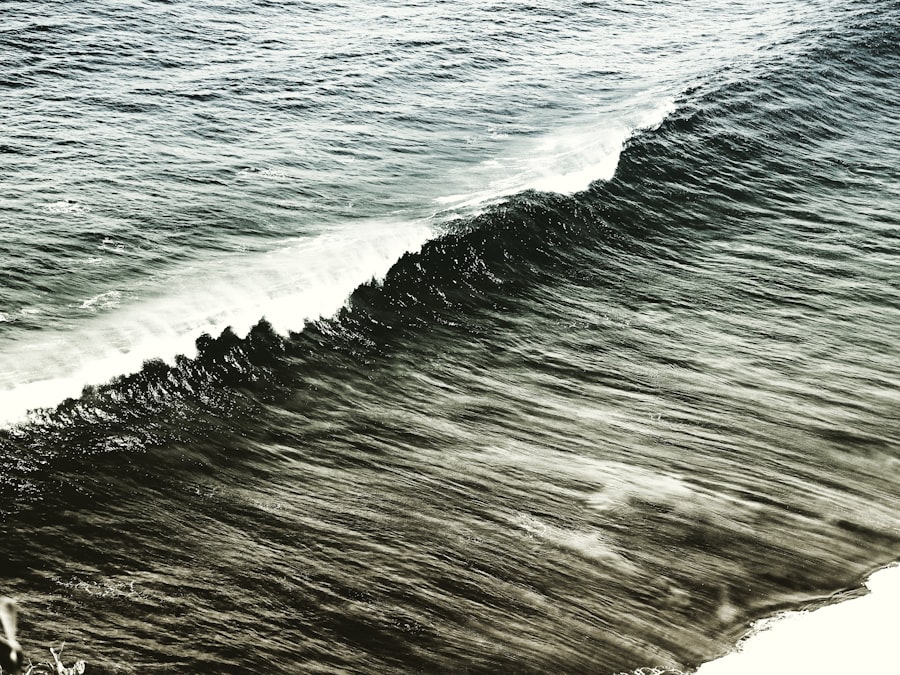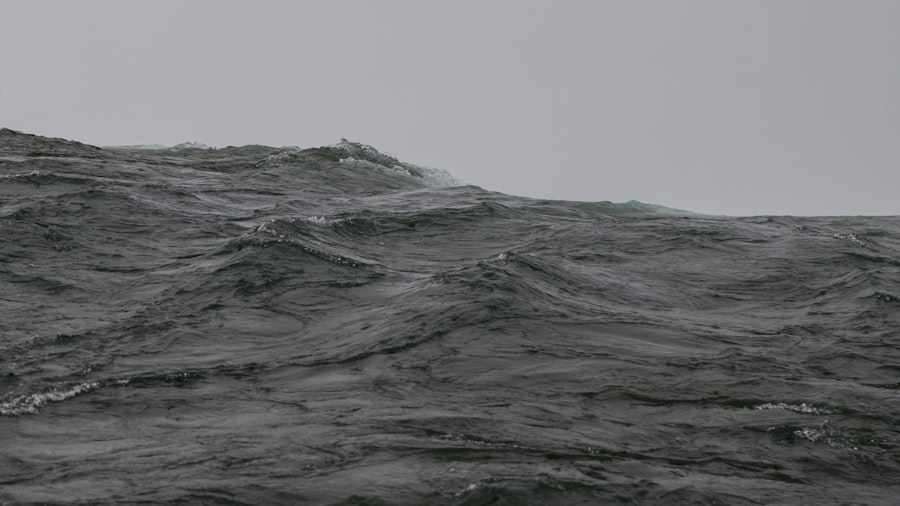The Drake Passage, a body of water located between the southern tip of South America and Antarctica, is renowned for its tumultuous seas and unpredictable weather patterns. Spanning approximately 800 kilometers (500 miles) in width, it serves as a critical maritime route for vessels traveling to and from the Antarctic region. The passage is named after Sir Francis Drake, the English explorer who navigated these waters in the late 16th century.
Its unique geographical position makes it a confluence point for the Atlantic and Pacific Oceans, resulting in a complex interplay of currents that can lead to some of the most challenging sailing conditions in the world. The significance of the Drake Passage extends beyond its navigational challenges; it is also a vital ecological zone. The waters are rich in marine life, serving as a feeding ground for various species, including whales, seals, and seabirds.
The nutrient-rich upwellings in the area support a diverse ecosystem that is crucial for both local and global biodiversity. However, the same factors that contribute to its ecological richness also make the Drake Passage a formidable challenge for mariners. Understanding the dynamics of this passage is essential for anyone attempting to navigate its often treacherous waters.
Key Takeaways
- The Drake Passage is a narrow stretch of water between South America’s Cape Horn and the South Shetland Islands of Antarctica, known for its treacherous conditions.
- Weather plays a significant role in wave height in the Drake Passage, with strong winds and storms leading to higher waves that can pose a challenge for navigation.
- Historical wave height data in the Drake Passage shows a trend of increasing wave heights, likely influenced by climate change and rising sea levels.
- Climate change is expected to further impact wave height in the Drake Passage, making navigation more challenging and dangerous in the future.
- Navigating the Drake Passage presents significant challenges due to high waves, strong winds, and icebergs, requiring experienced and skilled navigators to safely traverse the area.
The Influence of Weather on Wave Height
Weather plays a pivotal role in determining wave height in the Drake Passage. The region is characterized by rapidly changing weather patterns, influenced by the convergence of cold polar air and warmer air masses from the north. This clash can lead to sudden storms, which can escalate wave heights dramatically within a short period.
Mariners must be acutely aware of these weather patterns, as they can dictate not only the safety of their journey but also the feasibility of navigating through the passage at all. In addition to storms, prevailing winds significantly affect wave formation and height. Strong winds can generate large swells that travel vast distances across the ocean, culminating in towering waves when they reach the shallow waters of the continental shelf.
The combination of wind speed, direction, and duration can create conditions that are both dangerous and unpredictable. As such, understanding weather forecasts and real-time meteorological data is crucial for anyone planning to traverse this challenging maritime route.
Historical Wave Height Data

Historical data on wave heights in the Drake Passage reveals a pattern of extreme conditions that have been documented over decades. Research indicates that wave heights can reach upwards of 15 meters (49 feet) during severe storms, making this passage one of the most perilous for seafarers. Historical records show that these extreme conditions are not isolated incidents; rather, they occur with alarming frequency, particularly during certain seasons when storms are more prevalent.
Analyzing historical wave height data also provides insights into long-term trends and variations in wave patterns. Researchers have noted fluctuations in wave heights over the years, which can be attributed to various factors, including seasonal changes and broader climatic shifts. This data is invaluable for understanding the risks associated with navigating the Drake Passage and for developing strategies to mitigate those risks.
By studying past events, mariners can better prepare for future voyages through these tumultuous waters.
The Impact of Climate Change on Wave Height
| Location | Wave Height (m) | Year |
|---|---|---|
| California Coast | 2.5 | 2020 |
| Great Barrier Reef | 3.2 | 2019 |
| North Sea | 4.1 | 2018 |
Climate change has emerged as a significant factor influencing wave height in the Drake Passage. As global temperatures rise, so too do ocean temperatures, leading to alterations in weather patterns and oceanic currents. These changes can result in more frequent and intense storms, which in turn contribute to increased wave heights.
Studies have indicated that regions like the Drake Passage may experience more extreme weather events as climate change progresses, raising concerns for maritime safety. Moreover, the melting of polar ice caps contributes to rising sea levels and changes in salinity and temperature gradients within ocean waters. These shifts can further exacerbate wave conditions, creating an environment where high waves become more common.
The implications of these changes are profound, not only for navigation but also for marine ecosystems that rely on stable conditions. As climate change continues to reshape the environment, understanding its impact on wave height becomes increasingly critical for those who navigate these waters.
Navigational Challenges in the Drake Passage
Navigating the Drake Passage presents numerous challenges that require skill, experience, and careful planning. The unpredictable nature of weather conditions means that mariners must be prepared for sudden changes that can affect visibility and sea state. Fog, rain, and strong winds can all contribute to hazardous sailing conditions, making it essential for navigators to remain vigilant and adaptable throughout their journey.
In addition to weather-related challenges, the geography of the passage itself poses risks. The presence of icebergs and shifting currents can create obstacles that are difficult to detect until it is too late. Mariners must be adept at using navigational tools and techniques to avoid these hazards while maintaining course through turbulent waters.
The combination of environmental factors and geographical features makes the Drake Passage one of the most demanding maritime routes in existence.
Safety Precautions for Navigating High Waves

Given the inherent dangers associated with high waves in the Drake Passage, implementing safety precautions is paramount for any vessel attempting to navigate these waters. One of the most critical measures is ensuring that all crew members are well-trained in emergency procedures and safety protocols. Regular drills should be conducted to prepare for potential scenarios such as capsizing or man-overboard situations.
Additionally, vessels should be equipped with appropriate safety gear, including life jackets, lifeboats, and communication devices capable of functioning in extreme conditions. Mariners should also consider investing in advanced stabilization technology that can help mitigate the effects of high waves on vessel stability. By prioritizing safety measures and ensuring that all crew members are prepared for emergencies, vessels can significantly reduce their risk while navigating through this challenging passage.
Technology for Monitoring Wave Height
Advancements in technology have revolutionized how wave height is monitored in the Drake Passage and other maritime regions. Satellite imagery and remote sensing technologies allow researchers and mariners to gather real-time data on wave conditions across vast areas of ocean.
In addition to satellite technology, buoys equipped with sensors are deployed throughout the passage to provide continuous monitoring of wave height and other oceanographic parameters. These buoys transmit data back to shore-based facilities where it can be analyzed and disseminated to mariners in real time. By leveraging these technological advancements, navigators can gain a clearer understanding of current conditions and make better-informed choices about their routes.
Strategies for Minimizing the Impact of High Waves
To minimize the impact of high waves while navigating the Drake Passage, mariners can employ several strategies that enhance safety and efficiency. One effective approach is to adjust sailing routes based on real-time weather data and wave forecasts. By avoiding areas known for particularly high waves or severe weather conditions, vessels can reduce their exposure to dangerous situations.
Another strategy involves modifying vessel speed and heading to better align with prevailing wave patterns. By sailing at an angle to incoming waves rather than directly into them, vessels can reduce the risk of capsizing or sustaining damage from high swells.
These proactive measures can significantly enhance safety while navigating through one of the world’s most challenging maritime environments.
The Role of Experience in Navigating the Drake Passage
Experience plays a crucial role in successfully navigating the Drake Passage. Seasoned mariners possess an intuitive understanding of how to read weather patterns and interpret oceanic conditions based on years of firsthand experience. This knowledge allows them to make quick decisions that can mean the difference between a safe passage and a perilous situation.
Moreover, experienced navigators are often adept at utilizing traditional seamanship skills alongside modern technology. They understand how to balance reliance on instruments with their own instincts and observations, which can be particularly valuable in rapidly changing conditions. The combination of experience and skill is essential for anyone attempting to traverse this notoriously challenging body of water.
The Importance of Planning and Preparation
Thorough planning and preparation are vital components of any successful voyage through the Drake Passage. Mariners must conduct comprehensive research on weather forecasts, historical wave data, and potential hazards before setting sail. This preparation includes developing contingency plans for various scenarios that may arise during the journey.
Additionally, ensuring that all equipment is in optimal working condition prior to departure is essential for safety. Regular maintenance checks on navigation systems, communication devices, and safety gear can prevent malfunctions during critical moments at sea. By prioritizing planning and preparation, mariners can significantly enhance their chances of navigating through the Drake Passage safely.
The Future of Navigating the Drake Passage
As climate change continues to influence oceanic conditions worldwide, the future of navigating the Drake Passage may see significant transformations. Increased storm frequency and intensity could lead to even more challenging sailing conditions than those currently experienced by mariners today. This evolving landscape necessitates ongoing research into wave patterns and weather phenomena specific to this region.
Furthermore, advancements in technology will likely play a pivotal role in shaping future navigation strategies within the passage. Enhanced monitoring systems will provide real-time data that allows mariners to make informed decisions based on current conditions rather than relying solely on historical trends or forecasts. As navigational techniques evolve alongside environmental changes, mariners will need to adapt their approaches to ensure safe passage through one of nature’s most formidable maritime challenges.
The Drake Passage, known for its turbulent waters, is a subject of fascination for many maritime enthusiasts and researchers. The waves in this region can reach impressive heights, often challenging even the most experienced sailors. For those interested in learning more about the dynamics of the Drake Passage and its formidable waves, a related article can be found on MyGeoQuest. This article delves into the geographical and meteorological factors that contribute to the passage’s notorious reputation. You can read more about it by visiting this page on MyGeoQuest.
WATCH NOW! Drake Passage: Earth’s Deadliest Waters Revealed
FAQs
What is Drake Passage?
Drake Passage is the body of water between the southern tip of South America at Cape Horn and the South Shetland Islands of Antarctica. It is known for its rough seas and challenging sailing conditions.
How high can waves get in Drake Passage?
Waves in Drake Passage can reach heights of up to 30 meters (98 feet) during extreme weather conditions. These waves are some of the largest in the world due to the strong winds and currents in the area.
Why are the waves in Drake Passage so high?
The waves in Drake Passage can reach such extreme heights due to the combination of strong westerly winds, the Antarctic Circumpolar Current, and the relatively narrow width of the passage. These factors create a perfect storm for the formation of massive waves.
Are there any dangers associated with the high waves in Drake Passage?
Yes, the high waves in Drake Passage pose significant dangers to ships and other vessels navigating through the area. The rough seas and extreme weather conditions can make sailing through the passage treacherous and challenging.
Are there any measures taken to mitigate the risks of high waves in Drake Passage?
Ships and vessels that traverse Drake Passage often take precautions to minimize the risks associated with the high waves. This may include careful route planning, utilizing advanced weather forecasting technology, and ensuring that vessels are equipped to handle rough seas.
